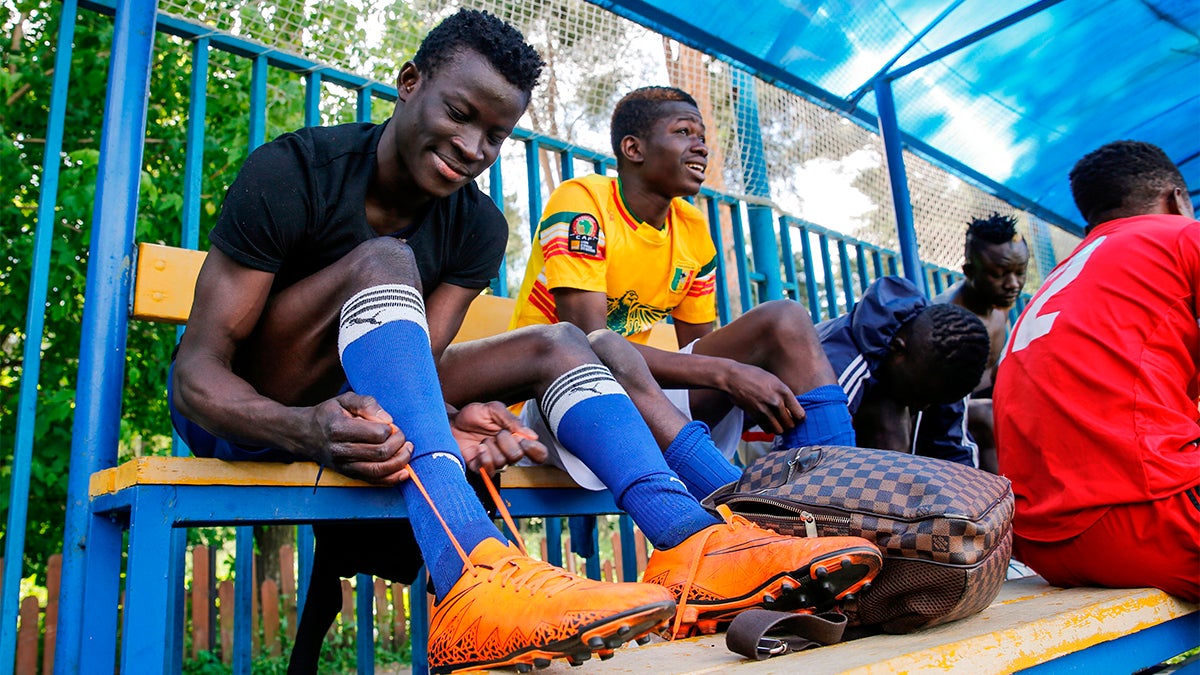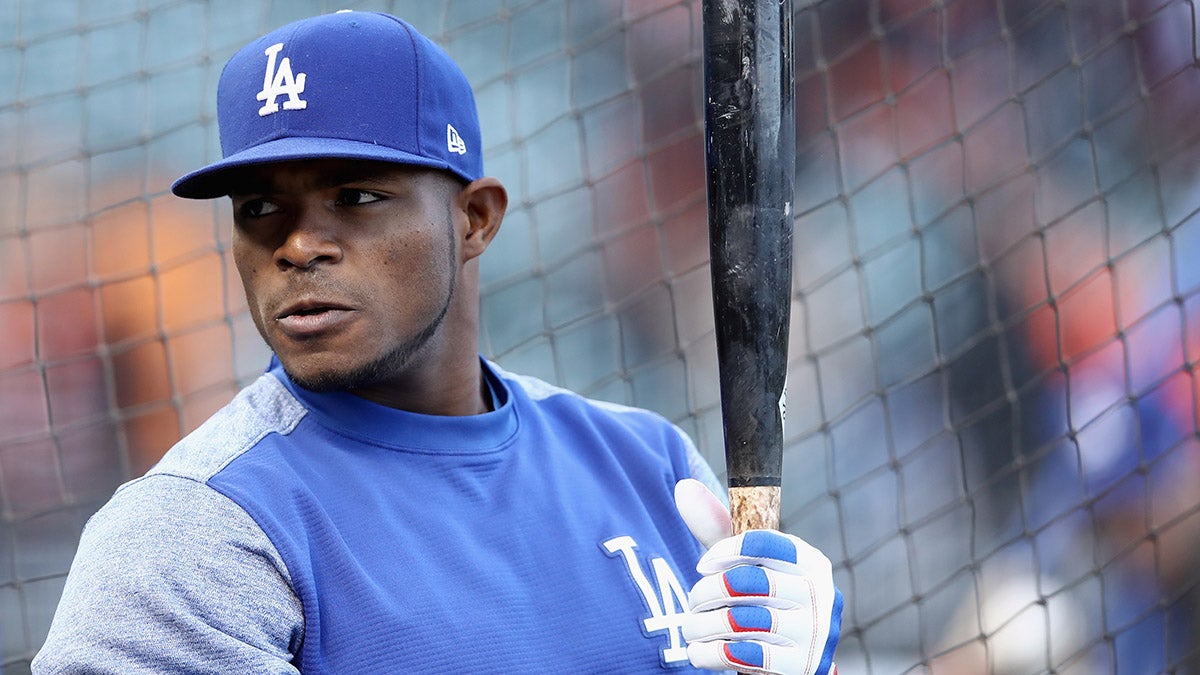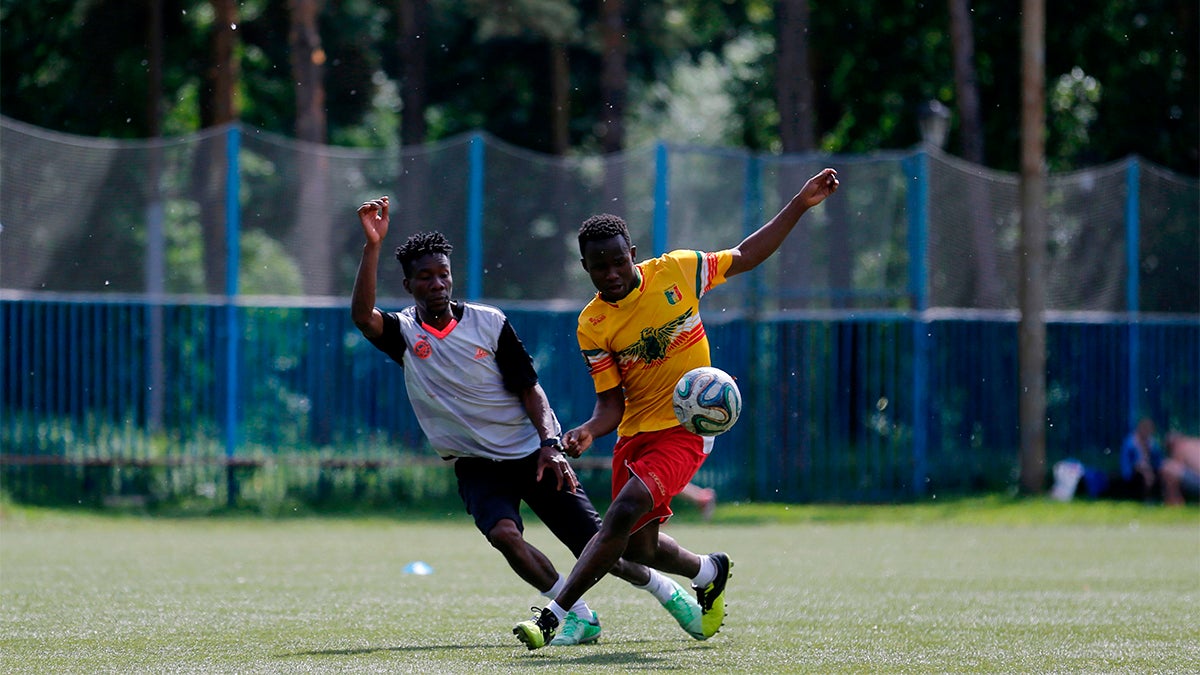Traffickers lure athletes with dreams of sporting glory only to abandon them far from home

Kesselly Kamara left Africa and his home country of Liberia when he was 14, lured by the promise of a career in soccer. Because Liberia has no soccer academy, Kamara went to Laos, having been promised, he later said, a six-year contract with the “IDSEA Champasak Asian African Football Academy” that included salary and accommodation.

But Kamara claimed he was never paid. He slept on the floor of the stadium with 30 other young players. They ate bread and rice, they had no coach or medical staff or class schedule, and they played no games. And, in the end, it appears the academy Kamara signed with never existed. When Kamara and his teammates tried to leave, they were told that they couldn’t unless they paid for their accommodations and food. In essence, they were trapped in a strange country, with no promise of a future.
It took the intervention of FifPro, the world union of soccer players, to get Kamara and his teammates out of Laos and back to Liberia in 2015. And in the years since, FifPro legal director for Europe Roy Vermeer tells GlobalSport Matters, the number of stories that echo Kamara’s has proliferated.
When thinking of human trafficking in sports, people tend to think of off-field concerns: The exploitation of sex workers at major sporting events such as the Super Bowl, for instance. But athletes, most notably in soccer, have been exploited by unscrupulous fixers seeking to take advantage of young people who frequently hail from underprivileged African countries. Sometimes, they’re lured to countries such as Laos or Nepal, which allows visitors from nearly any country to get a visa on arrival; other times, they end up in major European cities such as Paris, where they’re promised trials with major clubs such as Marseille and Real Madrid before being abandoned by their handlers. On occasion, they do get a tryout without guarantees of making a club; but often, they’re lured under false pretenses, and have to fend for themselves. One study by immigration authorities in Portugal showed 157 soccer players were living in the country illegally — 105 from African countries. In certain cases, the athletes are too ashamed to return home, and wind up vulnerable to crime, homelessness or sexual exploitation.
“(Agents) bring young people into the country and put them in clubs offering to act as rented wombs,” said Joaquim Evangelista, president of Portugal’s football players’ union. “If players are successful, profits are made from the transfer. If they are not and are notified by Immigration to return home, they have to pay their own tickets and are abandoned."
Those agents and fixers sometimes charge fees to the families who are willing to pay to send their children overseas to seek an opportunity — often anywhere between 2,000 and 6,500 British pounds, according to anti-trafficking charity Culture Foot Solidaire (CFS). While the number of legitimately fraudulent cases is difficult to estimate — CFS has put it as high as 15,000 — the lack of monitoring means it could be higher.
“The number of cases we receive that deal with exploitation are mind-boggling,” Vermeer said.
The problem was exacerbated in the 1980s and 1990s, when African teams began to perform strongly in youth world championship events. Even after FIFA, the governing body of soccer, passed Article 19 regulating stricter transfer regulations governing minors in 2001, the problem persists. And it’s such a muddled situation that even the intentions of organizations like Foot Solidaire have been called into question.
“It’s still going on,” said Peter Donnelly, a professor at the University of Toronto’s Centre for Sport Policy Studies. “And it’s gone even broader now with Middle East teams, east Asian teams and east European teams all picking up African players.”
Major clubs in Europe, including Real Madrid and FC Barcelona in Spain and Manchester City in the English Premier League, also have run afoul of the rules in recent years. And even if those weren’t overt cases of exploitation, experts said, the incidents showed clubs are so eager to find and recruit talent at a young age they’re often willing to circumvent the rules to get them.
It’s not just a problem in soccer. Donnelly has studied examples of trafficking of young athletes in hockey who are funneled to certain junior teams. One of the most egregious cases, Donnelly said, are jockeys who race camels on the Saudi peninsula. The sport is “kind of like horse racing in the rest of the world” in terms of popularity, Donnelly said. Because young children often make the best riders due to their size, Donnelly said they’re either bought or kidnapped from countries such as Pakistan and Bangladesh. Though it appears at least some of the issue has been remedied by replacing child jockeys with robots.

In track and field, meanwhile, top athletes are often persuaded to switch their nationalities to countries such as Azerbaijan, Qatar and Bahrain. In fact, every Olympic medal Bahrain has won was captured by an African athlete.
“They promised me a good salary, a house, and expensive cars if I won races,” Ethiopian middle-distance runner Lily Abdullayeva, who switched her national allegiance to Azerbaijan, told The Guardian in a 2017 expose. “But I never received any. I had my prize money stolen, was tricked into taking drugs and I would advise anyone against doing it.”
The Guardian’s reporting caught the attention of IAAF president Sebastian Coe, who admitted that previous regimes may have “failed to grasp the seriousness of the issue,” and promised actions to combat it. But this is where addressing the problem gets tricky.
As Foreign Policy’s Matthew Hall wrote last year, while FIFA’s Article 19 clearly hasn’t stopped the flow of young talent out of Africa, the question of what meets the legal definition of trafficking and who exactly should have the authority to deal with it raises further complications.
Case in point: A spokesman for FIFA told the website Geographical last year the organization could only regulate issues within the scope of organized football, and that “issues relating to ‘child trafficking’...fall within the competence of the relevant national and international authorities.”
In the meantime, Hall wrote, “most scammed players end up as silent victims. They are reluctant to speak publicly about their experiences, and there’s little pressure on authorities...to take meaningful action.”
This is not just a European problem. For years, Cuban baseball players seeking to play in America, including former Los Angeles Dodgers star Yasiel Puig, had to negotiate what CNN called a “vast and vicious” human-trafficking network in order to play baseball in America.
This is one area where authorities have agreed to take action: In 2018, Major League Baseball and the players association reached an agreement with the Cuban Baseball Federation to give Cuban players an alternative — any player 25 and older is now eligible to be released from his contract in Cuba to play in the United States. If the player is under 25, he would be subject to a waiting period, in order to discourage smugglers, since “smugglers want to be paid right away,” according to deputy MLB commissioner Dan Halem.
The problem is also evident in other American sports, including basketball. As United States coaches increasingly comb the world for talent, unscrupulous figures have begun to exploit athletes seeking an opportunity to play in the United States. One of the worst examples: Paterson Eastside High School in New Jersey, which faced major repercussions after a series of NJ.com exposés revealed six overseas players were living with the school’s boys basketball coach, and that an international pipeline had funneled athletes to Eastside over the course of several years.
In addition, a 2015 investigation by journalist Alexandra Starr revealed four Nigerian athletes wound up homeless and in foster care after being lured to play basketball for a Christian high school in Georgia.
“It’s like modern slavery,” one player told Starr.
By getting in early on rising stars, Starr wrote, “a whole international network of scouts, coaches and agents (are) looking to make real money by plucking rising-star basketball players from other countries and ‘getting in’ on the player’s circle of influence early.”
FifPro also released a warning about criminals posing as player agents for soccer stars on LinkedIn.
“I paid two fees: one to have trials whenever I would be without a club throughout my career, and a second to get a contract with the club,” one Australian player said of his LinkedIn experience. “Before going to the Asian country, I asked for the contract on several occasions. He kept on telling me that the club would send it any time and then urged me to go there as quickly as possible because the club needed me. When I arrived there, the club said that the only thing arranged was a trial. There was no contract. He did not give me a refund.”

So the question remains: What can be done to stem the tide of athlete trafficking in its various forms?
Vermeer, of FifPro, said cases like the one in Laos would benefit from more attention, swifter action and follow-ups to assure actions are not repeated. And Donnelly said academy systems in sports should be regulated, subject to strict age limits, and be forced to adhere to United Nations guidance on the rights of children. In the meantime, there have been hints international organizations are more serious about addressing the problem, but Donnelly said it’s only a start.
“Enough major sporting organizations have been shamed now that they’re all making noises about good governance,” Donnelly said. “They’re making some changes, but I’m not sure it’s anywhere near enough yet.”
The larger issue that Donnelly, Vermeer and others raise is the weaknesses in the system itself.
Vermeer said FifPro has been highly critical of the transfer system that allows players to be essentially commoditized. Vermeer pointed to the example of Lithuanian club FC Stumbras, which FifPro has accused of late payments and offering contracts that force players to pay up to three million Euros to terminate their contract, while the club can terminate the same contract without compensation over a period of 24 hours. A 2018 New York Times report singled out FC Stumbras as an example of what many clubs do to manipulate the transfer market to their advantage.
“The whole professional sports system is pretty much a meat market,” Donnelly said. “I can’t think of any other profession where workers are bought, sold and traded in this way.”
While it’s not as overtly exploitative as what is happening elsewhere in the world, Donnelly also cited the system of college athletics in America, in which amateur athletes are vulnerable to profiteering of a different sort.
“I think there’s a growing concern about universities and colleges in the United States, and their treatment of the players that they bring in on scholarship,” he said. “They’ve certainly become part of a club that’s making money for the university and for television companies.”
Michael Weinreb is a freelance writer for several outlets, and is working on a book about football as it relates to the evolution of American culture.

